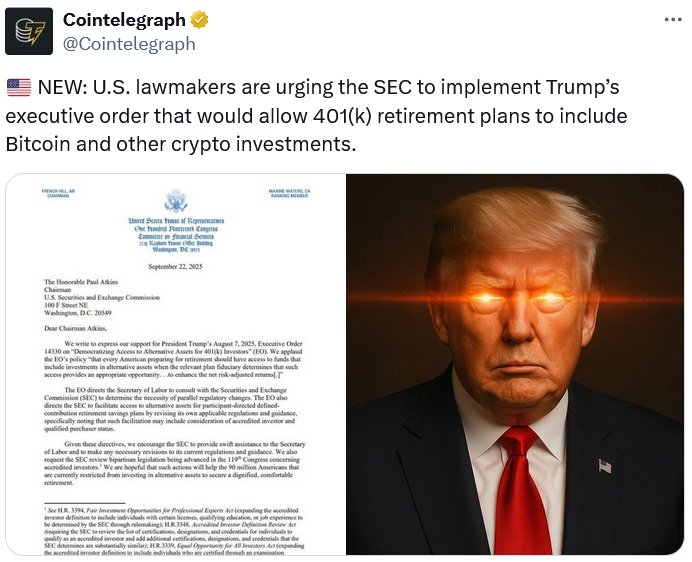Allowing crypto in 401(k) plans would let participants gain regulated exposure to digital assets; nine US lawmakers urged the SEC to act on the executive order to enable crypto investments in 401(k) plans and update guidance to permit modest allocations under fiduciary oversight.
-
Lawmakers asked the SEC to speed adoption of crypto in 401(k) plans
-
Even a 1% allocation of the $9.3 trillion 401(k) market could channel roughly $93 billion into crypto ETFs.
-
State pension moves show growing institutional appetite: Michigan added $10.7M to a bitcoin ETF in Q2.
Crypto in 401(k) plans: SEC urged to enable 401(k) crypto investments; learn potential inflows, fiduciary guidance, and next steps for plan sponsors.
Nine US lawmakers asked the SEC to move forward on last month’s EO to speed up the inclusion of alternative assets like crypto in US retirement funds.
US lawmakers have called on Securities and Exchange Commission Chair Paul Atkins to help accelerate the executive order enabling crypto investments in US 401(k) retirement plans. The letter requests regulatory adjustments and faster guidance to permit participant-directed crypto access under fiduciary rules.
In the letter on Monday, nine lawmakers, including House Financial Services Committee Chairman French Hill and Subcommittee on Capital Markets Chairman Ann Wagner, asked Atkins to “provide swift assistance” to the Secretary of Labor and update existing rules so alternative assets can be offered within 401(k) plans when appropriate.
The lawmakers referenced President Donald Trump’s August executive order on “Democratizing Access to Alternative Assets for 401(k) Investors,” which instructed agencies to consider how accredited investor and qualified purchaser rules affect participant access to alternative assets like crypto.

Source: Cointelegraph
What would enabling crypto in 401(k) plans mean for retirement investors?
Allowing crypto in 401(k) plans would give plan participants regulated exposure to digital assets under plan fiduciaries, potentially improving diversification and long-term returns for some investors. Any inclusion would be subject to fiduciary duty, risk assessment, and plan design controls.
How much capital could flow into crypto from modest 401(k) allocations?
Even a 1% allocation of the $9.3 trillion held in US 401(k) plans could direct roughly $93 billion into crypto exchange-traded products. For context, spot Bitcoin ETPs attracted about $60.6 billion since January 2024. Small percentage allocations at scale matter.
Why are lawmakers pressing the SEC now?
Lawmakers argue that regulatory clarity is required after the Labor Department reversed prior anti-crypto guidance in May. The letter urges the SEC to align its rules to facilitate access while preserving investor protections for fiduciaries and plan participants.
Frequently Asked Questions
Can plan sponsors add crypto to 401(k) plans today?
Not universally. Sponsors must follow ERISA fiduciary duties and existing SEC and Labor Department guidance; lawmakers want the SEC to issue updated rules to clarify when crypto can be offered as a plan option.
Who signed the letter urging the SEC to act?
Signatories include French Hill, Ann Wagner, Frank D. Lucas, Warren Davidson, Marlin Stutzman, Andrew R. Garbarino, Michael V. Lawler, Troy Downing, and Mike Haridopolos.
Are public funds already investing in crypto?
Yes. Example: the State of Michigan Retirement System bought $10.7 million of the ARK 21Shares Bitcoin ETF in Q2 and held shares of the Grayscale Ethereum Trust valued at about $15.6 million.
Key Takeaways
- Regulatory action requested: Nine lawmakers asked the SEC to implement the executive order facilitating crypto in 401(k) plans.
- Large potential inflows: A small percentage of the $9.3 trillion 401(k) market could deliver meaningful capital to crypto ETFs.
- Fiduciary safeguards required: Any adoption will hinge on ERISA-compliant processes, custodial arrangements, and participant education.
Conclusion
Lawmakers pressing the SEC to enable crypto in 401(k) plans could accelerate regulated access to digital assets for millions of retirement savers. Implementation depends on updated SEC guidance, Labor Department alignment, and careful fiduciary design. Watch for forthcoming rule changes that will determine how and when crypto becomes a standard retirement option.






